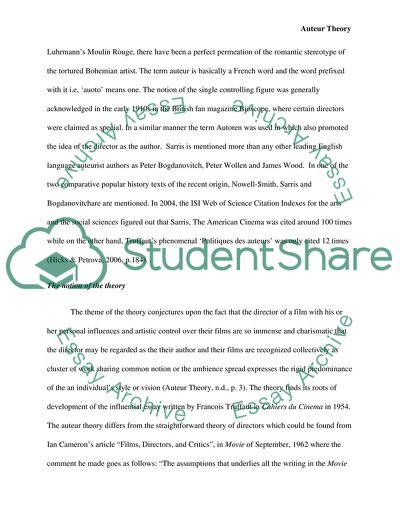Cite this document
(Auteur Theory & Directorial Burlesque Coursework, n.d.)
Auteur Theory & Directorial Burlesque Coursework. https://studentshare.org/visual-arts-film-studies/1777366-there-are-no-good-and-bad-films-only-good-or-bad-directors-francois-truffaut-in-walz-1982-8-discuss-the-auteur-theory-with-detailed-reference-to-one-director-currently-working-anywhere-in-the-world
Auteur Theory & Directorial Burlesque Coursework. https://studentshare.org/visual-arts-film-studies/1777366-there-are-no-good-and-bad-films-only-good-or-bad-directors-francois-truffaut-in-walz-1982-8-discuss-the-auteur-theory-with-detailed-reference-to-one-director-currently-working-anywhere-in-the-world
(Auteur Theory & Directorial Burlesque Coursework)
Auteur Theory & Directorial Burlesque Coursework. https://studentshare.org/visual-arts-film-studies/1777366-there-are-no-good-and-bad-films-only-good-or-bad-directors-francois-truffaut-in-walz-1982-8-discuss-the-auteur-theory-with-detailed-reference-to-one-director-currently-working-anywhere-in-the-world.
Auteur Theory & Directorial Burlesque Coursework. https://studentshare.org/visual-arts-film-studies/1777366-there-are-no-good-and-bad-films-only-good-or-bad-directors-francois-truffaut-in-walz-1982-8-discuss-the-auteur-theory-with-detailed-reference-to-one-director-currently-working-anywhere-in-the-world.
“Auteur Theory & Directorial Burlesque Coursework”. https://studentshare.org/visual-arts-film-studies/1777366-there-are-no-good-and-bad-films-only-good-or-bad-directors-francois-truffaut-in-walz-1982-8-discuss-the-auteur-theory-with-detailed-reference-to-one-director-currently-working-anywhere-in-the-world.


